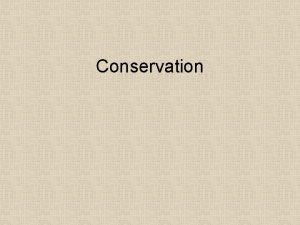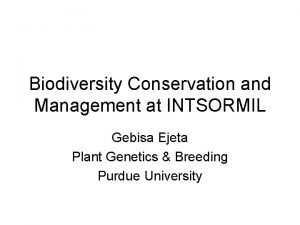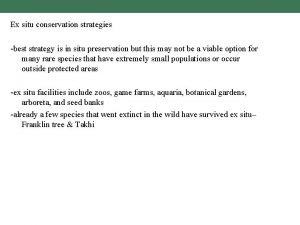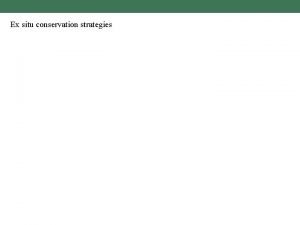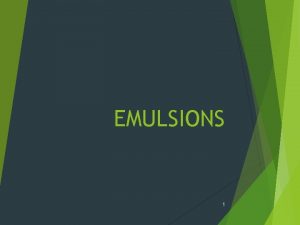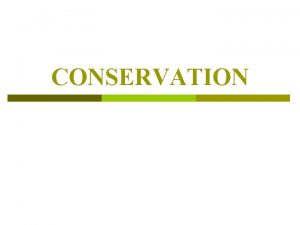In situ conservation In situ conservation Conservation in






- Slides: 6

In situ conservation

In situ conservation Conservation in Situ Conservation in situ means conserving species in a natural habitat by attempting to minimise human impact in order to maintain biodiversity. Legislation • Used to stop hunting, logging and clearing land for agriculture • The legislation is only specific to a particular country (where its needed) • It can be difficult to enforce legislation when a Government doesn't agree to it Wildlife Reserves These are designated areas set aside for the conservation of species or habitats The principles of choosing Wildlife reserves: • Comprehensiveness: how many species are represented in the area and what are the prevailing environmental conditions • Adequacy: is the area large enough to provide for the long term survival of all the species, populations and communities • Representativeness: is there a full range of diversity within each species and each set of environmental conditions

Wildlife reserves In the past reserves have been set up without consideration of the local people, and this has led to conflict. The reasons for this can be: • Tourist leaving litter or feeding protected animals • People continuing to hunt protected animals • Illegal harvesting of timber and other plant

Wildlife reserves in the U. K. There are numerous wildlife reserves in the U. K, these include: • National parks: there a total of 15 in the U. K, these areas of protected countryside. Anyone can visit, live or work here. • National Nature Reserves (NNR): these are set up to protected sensitive features of the environment, and also enable scientific research and education. There almost 400 in the UK that protect vegetation. • Sites of special scientific interest (SSSIs): there are over 6000 in the U. K, these are wildlife and geological sites. They include large wetlands, winding chalk rivers, flower-rich meadows, shingle beaches etc. • Marine conservation zones: there are 27 of these sites in the U. K coast, that were made conservation zones in 2013. These support biodiversity of threatened habitats and species.

Advantages of in situ conservation • • • Plants and animals are conserved in their natural habitat. Biodiversity and natural/cultural heritage is protected. Ecological integrity is maintained and managed. It facilitates scientific research. Can restore damage caused by poaching. Larger populations can be protected. It is less disruptive than removing organisms from their habitat. Recovery is more likely to occur than in ex situ conservation. It is cheaper and more convenient.

Disadvantages of in situ conservation • • Endangered habitats may be damaged so areas may not be large enough to allow survival of the species. Genetic diversity may have already been lost within the species. Outside factors that affected populations before may still be present, i. e. : diseases, interspecific competition. Poachers and ecotourists may see thriving area as an opportunity for further hunting, so damage still continues. Overall, the advantages outweigh the disadvantages, as it is a better and safer way to keep natural populations and habitats.
